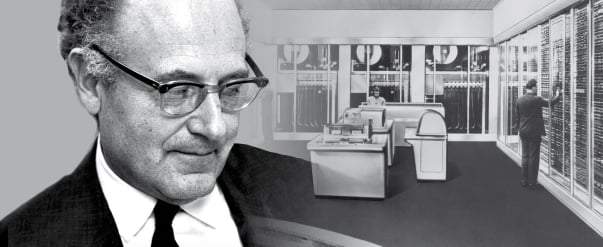
The Department of Computer Science is distinguished by cross-disciplinary collaboration.
At 30 years, the Department of Computer Science is the youngest department in the Whiting School. The “father” of the discipline at the university may be William H. Huggins, who was a professor of electrical engineering from 1954 to 1984. It was he who encouraged Johns Hopkins administrators to acquire the university’s first computer in the early 1960s, and he became a strong proponent of using computers as teaching tools.
According to a colleague, Huggins “was very much ahead of the curve and knew that personal computing would be a big thing—he foresaw that development.” Through Huggins’ efforts as chair of the Department of Electrical Engineering, instruction in computer science began as an interdisciplinary program. This collaborative program with the departments of Statistics and Operations Research lasted until 1983, when computer science became part of electrical engineering. In just a few short years, computer science had significant growth and broke away to become the Whiting School’s ninth department, in 1986.
Gerald Masson, an expert in fault-tolerant computing, was the first chair. In just five years, the faculty doubled to 10, with expertise in a variety of theoretical computer science specialties: artificial intelligence, computational geometry, computer-aided design, and natural language processing, to name several.
Over the decades, the pervasive use of computers in society has provided a rich environment for cross-disciplinary collaboration involving the department. Additionally, Masson’s decision to populate the department with young faculty members and “let them do their own thing” has resulted in innovative partnerships and courses as well as highly regarded research centers. One example is the Johns Hopkins University Information Security Institute, established in 2000 as an entity that would focus the university’s expertise on problems such as personal privacy, confidentiality of electronic data, and the security of computer systems.
In the 1960s, Huggins created an early computer-generated movie that lasted just 32 seconds. Today, faculty members in the Department of Computer Science continue to build on his far-sighted thinking, pushing the boundaries of knowledge in areas such as theory and programming, systems, information security, machine learning and data- intensive computing, language and speech processing, computational biology and medicine, as well as robotics, vision, and graphics.
“While computer science is a young field, our department was especially youthful—when I arrived in 1988, there were only two tenured faculty members and a large group of assistant professors. This environment helped define the spirit of our department: enthusiastic, energetic, and willing to try new approaches and to take advantage of opportunities. In only a few years, we developed world-leading centers in robotics, natural language processing, and computer security, starting from nothing.”
—Scott Smith, professor of computer science
Click here to learn about research activities today at the Department of Computer Science.




